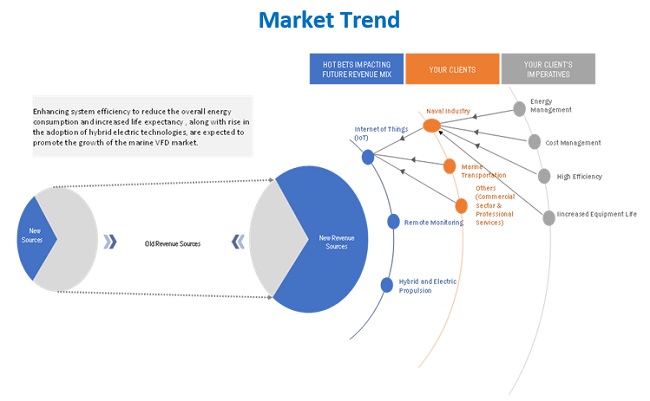The marine VFD market is expected to grow from an estimated USD 804 million in 2021 to USD 1,075 million by 2026, at a CAGR of 6.0% during the forecast period. Marine VFD are increasingly being installed across Europe and Asia Pacific region and is showing robust growth. Increasing demand of energy efficient systems on ships and move to cut down carbon emission across the globe are expected to offer lucrative opportunities for the marine VFD market during the forecast period.
Key Market Players:
A few major players that have a wide regional as well global presence and dominate the marine VFD market. The leading players in the marine VFD market include Siemens (Germany), ABB (Switzerland), GE (US), Rockwell Automation (US), and Danfoss (Denmark).
Download PDF Brochure: https://www.marketsandmarkets.com/pdfdownloadNew.asp?id=85395523
Asia Pacific is expected to show a robust growth during the forecast period. The Asia Pacific region includes China, Japan, South Korea, India, Australia, and Rest of Asia Pacific. This region has shown strong demand for marine VFD owing to rapid growth of shipbuilding industry. With the shift towards decarbonization, there has been a strong demand for more energy efficient engines with less emissions. Governments in this region are increasingly opening gates for development and growth of ship building industry. Technological advancements and less energy consumption would further propel marine VFD deployment and open up opportunities in the emerging markets in APAC. Various countries are adopting new hybrid and electric systems in ships in order to save energy as well as to meet their goal of rection in carbon emission Moreover, favourable supportive schemes, huge investments in ship building and port development would further drive the market for marine VFD. The market in China is expected to grow mainly because of government initiatives to cut down carbon emissions as well as to become leader in ship building.

The report segments the marine VFD market, by application, into pump, fan, compressor, propeller and crane & hoist. The propeller is further classified into with shaft generator and without shaft generator. The market for pump is expected to hold the highest market share during the forecast period. The pump is the component which is extensively used for various purposes onboard a ship and is critical for proper functioning of any ship. Thus, the use of VFD to control the functioning the pumps can save a lot of energy. Air compressors increase pressure in the machine chamber and produce compressed air by reducing the volume of air. Various types of air compressors are used on a ship, depending on the application. A compressor is a multipurpose device used in various applications, ranging from the cleaning of filters to starting the main or secondary engines of a ship. Compressors are also used to run the propellers in a ship. There are several types of compressors, among which rotary, reciprocating, centrifugal, and screw type are mainly used in ships
On the basis of voltage, the marine VFD market is categorized into low voltage VFDs (up to 1000 V) and medium voltage VFDs (above 1000 V). The low voltage segment accounted for a larger share, owing to the increased use of low-voltage motors in the marine industry across applications such as cranes, pumps, fans, and hoists. The increasing use of variable drives to improve the efficiency of various small components across a system equipped with motors to improve the efficiency of such systems has boosted the market for low-voltage drives. However, the medium voltage segment is expected to grow at a higher rate during the forecast period, as medium-voltage VFDs help in higher energy savings compared with low-voltage VFDs. The use of medium-voltage drives is gaining importance for larger applications as propulsion systems, shaft generators, etc.
Request Sample Pages: https://www.marketsandmarkets.com/requestsampleNew.asp?id=85395523
The marine VFD market has been segmented on the basis of type into AC drives and DC drives. AC drives are more widely used VFDs. The AC drive segment is projected to account for a larger market share, driven by the increasing demand for energy-efficient solutions. An AC drive is used to control the speed of an electric motor by changing the frequency and voltage of electric supply to the motor. A VFD controls the speed of the AC motor by changing the frequency supplied to the motor. The controller also adjusts the output voltage in proportion to the output frequency to provide a relatively constant voltage/frequency ratio (V/Hz), as required by the characteristics of the AC motor to generate sufficient torque. DC drives control the speed of a DC motor by regulating the voltage supplied to the motor to operate at the desired speed. A DC drive consists of a silicon-controlled rectifier (SCR) bridge, which converts the input three-phase or single-phase AC voltage into a DC voltage. In this conversion process, the DC drive can adjust the speed, torque, voltage, and current conditions of the DC motor. It is mainly used for high torque, low rotations per minute (rpm) applications, either as a new installation or a cost-effective retrofit. The main advantages of DC drives include excellent speed control, easy design, low cost for medium- and high-horsepower applications, and better speed regulation.


